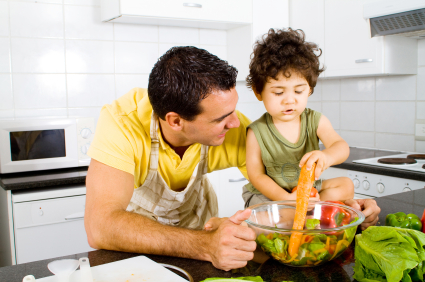There is a lot of talk about the importance of family meals. Your school age children may eat both breakfast and lunch in their school cafeteria. This is why it is important that the meals you eat with them are opportunities to teach healthy eating behaviors. Hopefully your children will carry these behaviors to the school lunchroom, and other settings. Listed below are meal-time tips you can use to encourage these healthy behaviors at home.
-
 Children are sponges! They learn from watching parents and older siblings. Try to eat as a family whenever you can. Include a good variety of foods, including vegetables. This is also a great time for conversations and practicing table manners.
Children are sponges! They learn from watching parents and older siblings. Try to eat as a family whenever you can. Include a good variety of foods, including vegetables. This is also a great time for conversations and practicing table manners. - Ask about lunch! Talk about school meals and what your children are eating. Try to understand why they make the choices they do.
- Learn what they like! Food preferences need to be respected and acknowledged. Teach young children to say “No, thank you” politely if they do not want any more after that. Make sure that the focus is on the great taste of the new foods you are trying. Even at a young age, many kids associate “good for you” with “tastes bad.”
- Experiment with new foods! Encourage kids to try one bite so they can expand their horizons.
- Don’t give up! Serve the foods your children previously resisted. It often takes several times of introducing a food before children eat and enjoy it.
- Try to resist the “forbidden foods” label! All foods can be part of a healthy diet.
- Encourage them in meal preparation! Let kids help with meal preparation according to their age and skill level. Children are more willing to try foods, especially if they helped prepare them. Even young children can tear lettuce, rinse broccoli or even set the table. Let them pick out a new fruit or vegetable to try the next time they go to the store with you.
- Be a creative cook! Cut foods into interesting shapes and make the plate attractive.
- Name foods with cute names and offer finger foods, such as sliced fruit and vegetables. Kids like inviting foods just like adults do.

- Give your time! Make the meal or snack your sole focus.
- Conversation is good. TVs or other electronics should wait until the snack or meal is complete.
- Allow them time to eat! Try not to rush the children when they eat. Time pressure puts stress on eating and makes it less pleasurable.
- A child’s world is play! Make eating a fun time. Include discussions about colors, textures and flavors.
- Have a lunch date at school! Consider going to your child’s school and eating lunch or breakfast with your child or children. Not only will you see what is offered at the school meals, you will also see what your child is choosing.
- Be positive! A positive attitude about school meals and trying new food is very important. Avoid generalizations, for example talking about “the food was when I was in school”.
- Grow it yourself! If you have a garden or a few plants, include the children in planting and harvesting the produce. Children who participate in planting foods, or at least see where their foods come from are more likely to try them. Many schools now have gardens or container gardens. If your child’s school has a garden, talk to them about the foods they are growing. This is a great way for you to be involved with your child’s school!
These are just a few simple ways we’ve found to get kids to explore the world of healthy food. If they work for you, please share them with all your friends!
Contributor
Liz Smith Ohio State University Extension
Source
Duyff, Roberta L. American Dietetic Association- Complete Food and Nutrition Guide, 4th Edition, 2012.
Photo by Rhoda Baer / CC BY Public Domain
